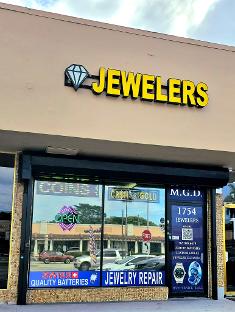Discover the Beauty and Value of Jewelry Across the Ages – Best Prices Paid!
At our store, we specialize in paying top dollar for rare and collectible jewelry from every decorative style period. Whether you’re selling heirlooms or vintage treasures, we value the history and artistry of each era. Learn more about the timeless elegance and unique features of jewelry through the ages:
GEORGIAN JEWELRY (1714–1837)
The Georgian period, named after the English King Georges I–IV, produced some of the rarest and most collectible jewelry. Highly dimensional designs, floral and scroll motifs, and gemstones like garnets and early rose-cut diamonds were common. These treasures, often set in rich 18-karat gold, sparkle with foil-backed fire best seen under candlelight. Due to their age and delicacy, Georgian jewels are ideal for collectors rather than everyday wear.
VICTORIAN JEWELRY (1837–1901)
Named for Queen Victoria, the Victorian period was marked by sentimental and symbolic designs. Hearts, snakes, flowers, and crescents were popular motifs, and a variety of gemstones—from turquoise and seed pearls to lavish diamonds—adorned these creations. Crafted in yellow gold and often accented with silver, Victorian jewelry is both eclectic and romantic.
ART NOUVEAU JEWELRY (1895–1915)
Art Nouveau jewelry is renowned for its fluid, nature-inspired motifs and imaginative craftsmanship. Female forms, flowers, dragonflies, and the iconic whiplash design feature prominently. While gemstones play a secondary role, vibrant fired enamels and plique-à-jour techniques create stunning, stained-glass-like effects. These pieces are prized for their artistic and whimsical charm.
EDWARDIAN JEWELRY (1901–1910)
Delicate and lacy, Edwardian jewelry is a testament to exquisite craftsmanship. Typically made of platinum or platinum over gold, these designs feature intricate piercing, diamond-studded bows, garlands, and pastel gemstones. Known in France as La Belle Époque, this era’s jewelry exudes elegance and femininity.
ART DECO JEWELRY (1920s–1930s)
Bold, geometric, and glamorous, Art Deco jewelry reflects the modernity of the Roaring Twenties. Platinum and white diamonds dominate, often accented with colorful sapphires or black onyx. Iconic pieces include elongated dinner rings, stacked bracelets, and sautoir necklaces. Art Deco is synonymous with sophistication and enduring style.
RETRO JEWELRY (1940s)
Retro jewelry emerged during WWII with dramatic, Hollywood-inspired designs. With platinum scarce, rose and rosy-yellow gold became the materials of choice. Oversized, asymmetrical creations often featured rubies, diamonds, and large semi-precious stones like aquamarine and citrine, capturing the glamour of Golden Age cinema.
MID-CENTURY JEWELRY (1950s–1960s)
The Fabulous Fifties brought platinum and diamonds back into focus, with abstract, floral, and free-form designs. Overlapping pave diamonds, brooches, and cocktail rings defined this era. Think Marilyn Monroe and Elizabeth Taylor—this was jewelry designed to dazzle.
THE SIXTIES
In the mid-to-late sixties, bold, colorful designs emerged with a pop-art and mod aesthetic. Asymmetry and geometric shapes became the hallmark, with inlays of turquoise, lapis, malachite, and tiger-eye set in yellow gold. These wearable art pieces capture the spirit of a rebellious yet creative decade.
1970s: Bohemian Chic and Glam Rock
Jewelry in the 1970s reflected a blend of earthy bohemian vibes and the bold flair of glam rock. Look for:
• Solid Precious Metals: Chunky gold chains, medallions, and silver cuffs.
• Natural Motifs: Pieces featuring turquoise, amber, or tiger’s eye set in gold or silver.
• Layered Looks: Long necklaces and stackable bangles made with solid materials stood out.
• Glam Details: High-polish gold and shimmering designs captured the era’s glamorous side.
1980s: Bold Statements and Power Dressing
The 1980s celebrated excess and opulence, with jewelry trends emphasizing boldness and luxury:
• Gold Dominance: Oversized solid gold chains, thick bracelets, and hoop earrings defined the decade.
• Gemstone Accents: Large diamonds, sapphires, rubies, and emeralds in gold or platinum settings.
• Signature Styles: Solid precious metal charm bracelets, statement earrings, and layered pearl necklaces.
• Celebrity Influence: Pieces inspired by icons like Princess Diana were crafted in high-quality materials.
1990s: Minimalist and Edgy
The 1990s shifted toward simplicity, with solid, timeless pieces and edgy designs made from precious materials:
• Chokers and Simple Chains: Gold, silver, or platinum chokers and delicate necklaces became staples.
• Minimalist Jewelry: Clean designs like solid gold or platinum bands, stud earrings, and fine bracelets.
• Grunge Influence: Darkened or oxidized silver and solid, edgy statement rings.
• Timeless Elegance: Genuine gold and silver pieces reflected the minimalist aesthetic of the time.
Early 2000s: Y2K Glam and Personalization
The early 2000s combined sparkle, individuality, and nostalgic charm in jewelry made from precious materials:
• Nameplate Necklaces: Solid gold and silver personalized pieces were a hallmark of the era.
• Dainty Layers: Thin gold and silver chains, often stacked, reflected modern elegance.
• Sparkling Accents: Pavé-set diamonds and gemstones in white gold or platinum.
• Playful Motifs: Butterflies, hearts, and stars crafted from solid gold or silver with gemstone accents.
We Buy Solid Gold, Silver, Platinum, and Precious Metal Jewelry from Every Era
When selling your jewelry, authenticity matters. We specialize in pieces made from solid gold, silver, platinum, and other precious metals, ensuring you receive top dollar for high-quality items. Whether your pieces are bold statements from the 1980s or minimalist treasures from the 1990s, we appreciate their true value.
Visit us today for a free appraisal and turn your solid metal jewelry into cash!
VISIT US TODAY
Monday - Thursday: 11am-5pm
Friday & Sunday: 11am-2pm
Saturdays: Closed
1754 NE 163rd ST
North Miami Beach, FL 33162
Call/Text: 305.989.6479

Copyright webuygoldnmb.com